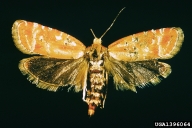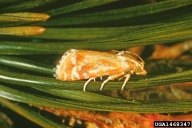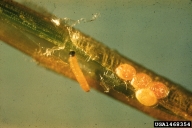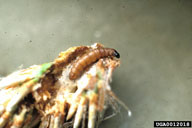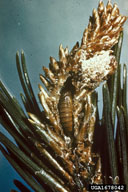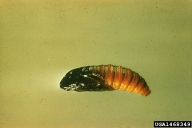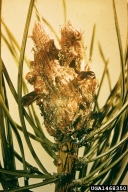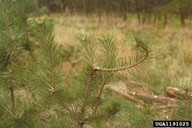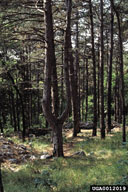European pine shoot moth
Rhyacionia buoliana (Denis and Schiffermiiller) (Lepidoptera: Tortricidae)
Orientation to pest
European pine shoot moth, Rhyacionia buoliana (Denis and Schiffermiiller), is an invasive tortricid native to Europe, the eastern Mediterranean region, and Japan. It is invasive in the United States, Canada, Chile, and Uruguay. It is a serious pest of pines, especially in pine plantations because it kills the leaders of pines, destroying their growing form. Larvae feed on pines, especially red pine (Pinus resinosa Sol. ex Aiton) or introduced European pines, and, in Southern Hemisphere plantations, on Monterrey pines (Pinus radiata D. Don). Buds of branches are also attacked. Moths emerge in early summer and lay their eggs on new needles. Young larvae construct webs that are coated with resin below the current year's needle sheaths and stems. Feeding initially occurs within the sheath at the base of needles. By midsummer, larvae switch and feed on buds until August. Larvae overwinter in webs at the bases of buds and in spring move to undamaged buds or new shoots, where they complete development. Pupation takes place during the second summer in the dead buds and shoots, and when adults emerge, empty pupal cases remain sticking out of the pupal chambers in the hollowed-out buds. One generation occurs each year. Death of leaders leads to deformed, bushy trees. In Chile, as much as a third of trees in Monterrey pine plantations may be infested.
Hosts commonly attacked
In North America, this moth attacks various native pines, especially red pine (P. resinosa), as well as several introduced European species, particularly Mugo (Pinus mugo Turra) and Scots (Pinus sylvestris L.) pines. The five-needle pines are relatively resistant. In the Southern Hemisphere, an important host is the North American species P. radiata, when grown in plantations.
Distribution
In North America, the moth occurs in southern Canada from Newfoundland to the Great Lakes and in the United States south to Maryland and Illinois. A separate infestation exists in British Columbia, Oregon, and Washington.
Images of European pine shoot moth
| Figure 1. Adults of European pine shoot moth, Rhyacionia buoliana | |
| Figure 2. Eggs (right) and first instar larva (left) of European pine shoot moth | Figure 3. Larva of European pine shoot moth feeding in shoot |
| Figure 4. Live pupa of European pine shoot moth in place in damaged shoot (left); pupa dissected from shoot (middle), and cast pupal skin (right) from damaged leader | |
| Figure 5. Deformation of shape of pine tree; left, in young tree; right, eventual tree shape (here, "Y") due to leader death from feeding of European pine shoot moth |
Important biological control agents related to this pest species
Many studies have described the parasitoids that can be reared from larvae and pupae of European pine shoot moth in various countries (United States, Canada, Chile, parts of Europe) and on various tree species. More than a hundred species of parasitoids have been recorded. Studies conducted in coastal areas of Germany in the 1950s and 1960s, for example, found larval and pupal parasitism of this species to be in the 28-65% range in pine plantations. The most common parasitoids observed were the ichneumonid Cremastus confluens Grav. and the braconid Orgilus obscurator Nees. Similar studies have been done in various locations, with some variation in the parasitoid guild. Several European parasitoid species were released in North America for suppression of this pest, but only a few have become established. Of these, only O. obscurator, appears to be widespread and of some importance. Releases of European parasitoids in North America have, however, had limited effect on densities of this pest in most areas. Possible explanations for this lack of control may include low vegetation diversity in North American pine plantations and a possible need to import additional species of parasitoids from Europe. Parasitoid importations against this species have also been undertaken in Chile.
Web links for information on European pine shoot moth
- Fact Sheet from FETCH 21 | University of British Columbia
- BugwoodWiki Article | wiki.bugwood.org
- Fact Sheet from Canadian Forest Service | Natural Resources Canada
- Datasheet from Invasive Species Compendium | CABI
Articles
- Schultz, A., D. Häussler, K. H. Apel, and E. K. Groll. 1997. RHYA-SIM - a model illustrating the population dynamics of the pine shoot moth (Rhyacionia buoliana). Beiträge für Forstwirtschaft und Landschaftsökologie 31 (2): 88-91. (in German)
- Daterman, G., A. Eglitis, D. Czokajlo, C. Sack, and P. Kirsch. 2001. Attract and kill technology for management of European pine shoot moth (Rhyacionia buoliana) and Western pine shoot borer (Eucosma sonomana), pp. 66-69. In: Knízek, M., B. Forster, and W. Grodzki (eds.). Methodology of forest insect and disease survey in central Europe. Proceedings of the Fourth Workshop of the IUFRO Working Party. Prague, Czech Republic, 17-20 September 2001. Journal of Forest Science 47 (Special Issue 2)
- Huerta, A., F. Robredo, J. Diez, and J. A, Pajares. 2006. The parasitoid complex selection of the European pine shoot moth (Rhyacionia buoliana Den. et Schiff.) (Lepidoptera: Tortricidae) for the biological control in Chile. Boletín de Sanidad Vegetal, Plagas 32 (4): 95-607. (in Spanish)
